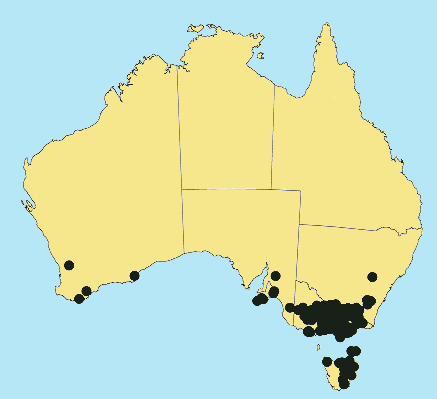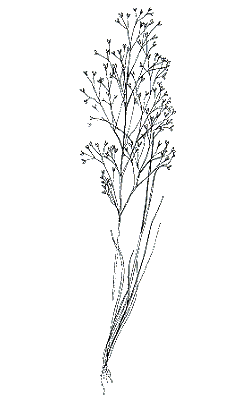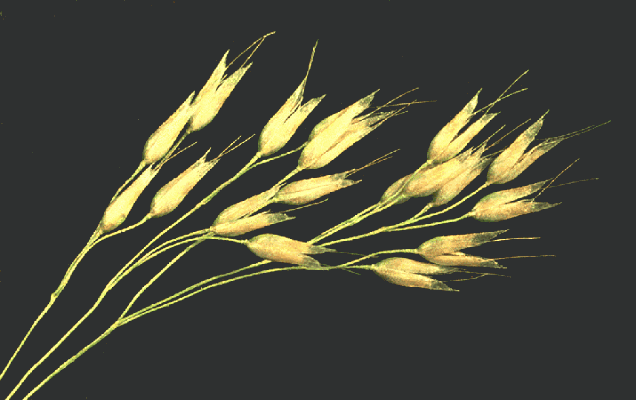Aira elegantissima* Schur. Verh.
Siebenb. Ver. Naturw. 4: 85 (1853). Classification. (GPWG 2001) : Subfamily Pooideae.
Tribe Poeae.
Common name:
Delicate Hairgrass.
Type of Basionym or
Protologue Information: Rumania, Hermannstadt: Schur .
Recent synonyms:
Aira elegans Willd. ex Gaudin.
Key references
(books and floras): [2002] D.Sharp & B.K.Simon, AusGrass, Grasses of
Australia, [2006] J.Jessop, G.R.M.Dashorst, F.M.James, Grasses of South
Australia (189), [2008] S.W.L.Jacobs, R.D.B.Walley & D.J.B.Wheeler, Grasses
of New South Wales (113), [2009] A.Wilson (ed.). Flora of Australia,
Vol 44A. Poaceae 2 (263).
Illustrations:
[2002] D.Sharp & B.K.Simon, AusGrass, Grasses of Australiia, [2006]
J.Jessop, G.R.M.Dashorst, F.M.James, Grasses of South Australia (189, fig. 137), [1984] N.T.Burbidge. rev.
S.W.L.Jacobs, Australian Grasses (43, as A. elegans), [2008]
S.W.L.Jacobs, R.D.B.Whalley & D.J.B.Wheeler, Grasses of New South Wales,
4th edn (113), [2009]. A.Wilson (ed.), Flora of Australia 44A: Poaceae
2 (260, Fig.35).
Derivation:
from the Latin elegans (elegant) and -issima (most). Very
attractive in some respect, usually the inflorescence.
Habit. Annual.
Culms erect or geniculately ascending, stature slender to delicate, 10–56 cm
tall. Leaves mostly basal. Ligule an eciliate membrane, 3–6.2 mm long, acute.
Leaf-blades filiform, flat or conduplicate or convolute, 2–8 cm long, 0.3–1.3
mm wide. Leaf-blade surface scaberulous, glabrous.
Inflorescence.
Inflorescence compound, a panicle. Panicle obovate, effuse, 3–13 cm long, 2–5
cm wide.
Spikelets.
Spikelets pedicelled. Fertile spikelets 2-flowered, both fertile, comprising 2
fertile floret(s), without rachilla extension, oblong, laterally compressed,
1.5–2.5 mm long.
Glumes. Glumes
similar, thinner than fertile lemma, shiny. Lower glume ovate, membranous,
keeled, 1-keeled, 1 -nerved. Upper glume ovate, 1.5–2.5 mm long, membranous,
keeled, 1-keeled, 1 -nerved.
Florets.
Fertile lemma 1.5–1.6 mm long, without keel, 5 -nerved. Lemma apex dentate,
awned, 1 -awned. Median (principal) awn dorsal, 1.5–2 mm long overall, with a
twisted column. Lodicules present. Anthers 3. Grain 0.95 mm long.
Continental
Distribution: Europe, Africa, Temperate Asia, Australasia, North America,
and South America.
Australian
Distribution: Western Australia, South Australia, New South Wales,
Victoria, Tasmania.
Western Australia:
Dale, Eyre. South Australia: Northern Lofty, Southern Lofty, Kangaroo
Island, South-eastern. New South Wales: Central Tablelands, Southern
Tablelands, South-Western Slopes. Victoria: East Gippsland, Eastern
Highlands, Gippsland Plain, Grampians, Lowan Mallee, Midlands, Otway Plain,
Riverina, Volcanic Plain, Wimmera. Tasmania: Furneaux Group, North West,
North East, Midlands, Ben Lomond, East Coast.
Notes. Introduced.
Occurring across southern Australia and W.A., not recorded in Qld. or the N.T.
Europe. Grows in pasture, disturbed grassland, waste land, roadsides or open
woodland; often in drier sites on shallow, rocky soils. Flowers Sept.-Mar.




